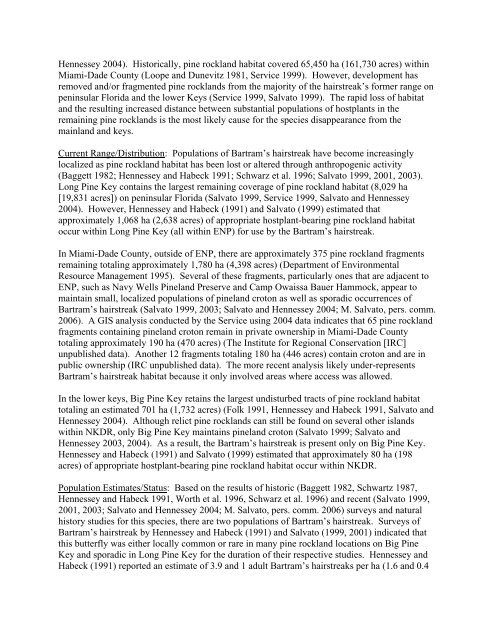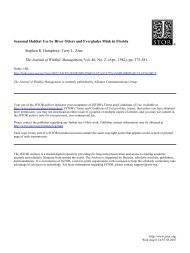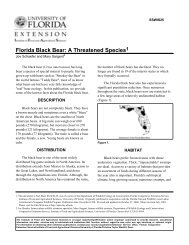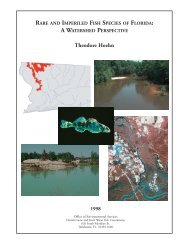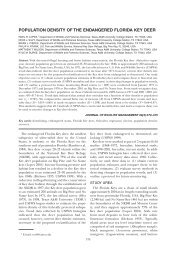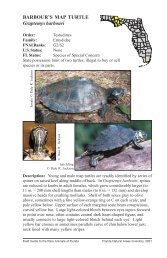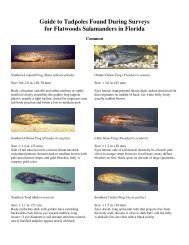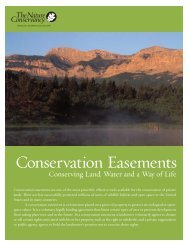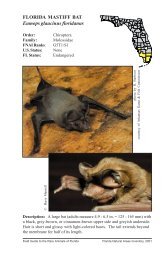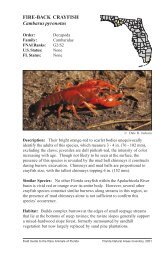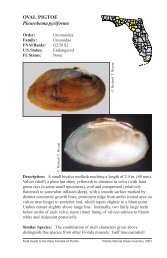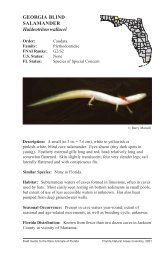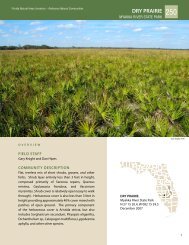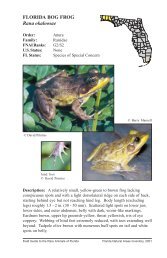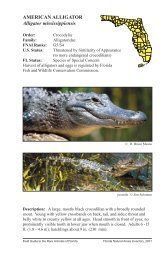Bartram's hairstreak butterfly - Florida Wildlife Conservation Guide
Bartram's hairstreak butterfly - Florida Wildlife Conservation Guide
Bartram's hairstreak butterfly - Florida Wildlife Conservation Guide
Create successful ePaper yourself
Turn your PDF publications into a flip-book with our unique Google optimized e-Paper software.
Hennessey 2004). Historically, pine rockland habitat covered 65,450 ha (161,730 acres) within<br />
Miami-Dade County (Loope and Dunevitz 1981, Service 1999). However, development has<br />
removed and/or fragmented pine rocklands from the majority of the <strong>hairstreak</strong>’s former range on<br />
peninsular <strong>Florida</strong> and the lower Keys (Service 1999, Salvato 1999). The rapid loss of habitat<br />
and the resulting increased distance between substantial populations of hostplants in the<br />
remaining pine rocklands is the most likely cause for the species disappearance from the<br />
mainland and keys.<br />
Current Range/Distribution: Populations of Bartram’s <strong>hairstreak</strong> have become increasingly<br />
localized as pine rockland habitat has been lost or altered through anthropogenic activity<br />
(Baggett 1982; Hennessey and Habeck 1991; Schwarz et al. 1996; Salvato 1999, 2001, 2003).<br />
Long Pine Key contains the largest remaining coverage of pine rockland habitat (8,029 ha<br />
[19,831 acres]) on peninsular <strong>Florida</strong> (Salvato 1999, Service 1999, Salvato and Hennessey<br />
2004). However, Hennessey and Habeck (1991) and Salvato (1999) estimated that<br />
approximately 1,068 ha (2,638 acres) of appropriate hostplant-bearing pine rockland habitat<br />
occur within Long Pine Key (all within ENP) for use by the Bartram’s <strong>hairstreak</strong>.<br />
In Miami-Dade County, outside of ENP, there are approximately 375 pine rockland fragments<br />
remaining totaling approximately 1,780 ha (4,398 acres) (Department of Environmental<br />
Resource Management 1995). Several of these fragments, particularly ones that are adjacent to<br />
ENP, such as Navy Wells Pineland Preserve and Camp Owaissa Bauer Hammock, appear to<br />
maintain small, localized populations of pineland croton as well as sporadic occurrences of<br />
Bartram’s <strong>hairstreak</strong> (Salvato 1999, 2003; Salvato and Hennessey 2004; M. Salvato, pers. comm.<br />
2006). A GIS analysis conducted by the Service using 2004 data indicates that 65 pine rockland<br />
fragments containing pineland croton remain in private ownership in Miami-Dade County<br />
totaling approximately 190 ha (470 acres) (The Institute for Regional <strong>Conservation</strong> [IRC]<br />
unpublished data). Another 12 fragments totaling 180 ha (446 acres) contain croton and are in<br />
public ownership (IRC unpublished data). The more recent analysis likely under-represents<br />
Bartram’s <strong>hairstreak</strong> habitat because it only involved areas where access was allowed.<br />
In the lower keys, Big Pine Key retains the largest undisturbed tracts of pine rockland habitat<br />
totaling an estimated 701 ha (1,732 acres) (Folk 1991, Hennessey and Habeck 1991, Salvato and<br />
Hennessey 2004). Although relict pine rocklands can still be found on several other islands<br />
within NKDR, only Big Pine Key maintains pineland croton (Salvato 1999; Salvato and<br />
Hennessey 2003, 2004). As a result, the Bartram’s <strong>hairstreak</strong> is present only on Big Pine Key.<br />
Hennessey and Habeck (1991) and Salvato (1999) estimated that approximately 80 ha (198<br />
acres) of appropriate hostplant-bearing pine rockland habitat occur within NKDR.<br />
Population Estimates/Status: Based on the results of historic (Baggett 1982, Schwartz 1987,<br />
Hennessey and Habeck 1991, Worth et al. 1996, Schwarz et al. 1996) and recent (Salvato 1999,<br />
2001, 2003; Salvato and Hennessey 2004; M. Salvato, pers. comm. 2006) surveys and natural<br />
history studies for this species, there are two populations of Bartram’s <strong>hairstreak</strong>. Surveys of<br />
Bartram’s <strong>hairstreak</strong> by Hennessey and Habeck (1991) and Salvato (1999, 2001) indicated that<br />
this <strong>butterfly</strong> was either locally common or rare in many pine rockland locations on Big Pine<br />
Key and sporadic in Long Pine Key for the duration of their respective studies. Hennessey and<br />
Habeck (1991) reported an estimate of 3.9 and 1 adult Bartram’s <strong>hairstreak</strong>s per ha (1.6 and 0.4


